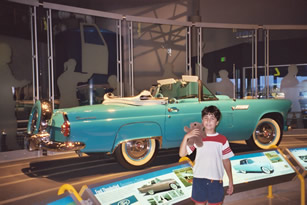Ford Motor Co.’s Dearborn Assembly Plant
This summer, rather than head to the beach or something else predictable, our family took a “manufacturing” vacation! I figured I’d better get the kids to some facilities before American manufacturing goes the way of the pterodactyl. We hit several interesting spots, so I decided to write a few installments on “the blog” to share with everyone, and maybe make you want to go check out your local manufacturing facilities.

Dearborn Truck Assembly Plant (Part 1)
As a Ford Taurus owner, I wanted to make my pilgrimage to Dearborn, MI, world headquarters of Ford Motor Co. and site of the renovated Dearborn Assembly Plant (the Rouge Factory) and Henry Ford Museum and Greenfield Village. I was most excited about the opportunity to see inside the truck assembly plant.
I really enjoyed the Ford Rouge Factory Tour, although it wasn’t as complete as I had hoped. Apparently the tour was changed some years ago because of safety concerns, and it no longer covers the welding or painting parts of the work. So, all we were able to see was the final assembly of the F150 trucks. (Another disappointment was that I did not see the Diego Rivera murals—I had thought they were part of the tour, but apparently they are at the Detroit Institute of Arts.)
The new Dearborn Assembly Plant was impressive, with lots of space and natural light. The facility was very clean, and not as noisy as I had expected. The workers did not seem rushed as they did their work on the passing vehicles. In fact, they seemed almost leisurely as they stepped on and off the moving line. When I commented on that to one of the guides, he smiled and said “yes, but remember they only have 43 seconds [to work on each vehicle as it passes by].”
I was also surprised to see how much of the work was still done by hand, by humans. We did see robots positioning the front windshield onto the frames, and there was a noisy and impressive point where the truck cab and bed came together. But, in general, we saw the workers putting on interior components of doors, pressing on rubber seals, and wiring up lights.
When 11:30 a.m. came, the line stopped and workers began to leave their stations for lunch. I noticed that each finished up the vehicle he/she was working on, rather than bolting for the door. I also noticed that a few of the workers stayed at their stations, opening lunch bags they had brought from home. I wondered if this was a way of being frugal, and whether it would make me lonely not to sit down to lunch with my coworkers.
Despite the good working environment, I thought I would be quickly bored by the repetitive nature of the job and the inability to “chat” with coworkers because of the noise.
Each worker or team had a work station with orderly stacked bins of parts needed for their part of the assembly. I read that these stations were supposed to have a 2-hour supply of parts. I assume this is part of the “Lean Manufacturing” ethic, but it seemed like it would have been more efficient to have a day’s worth. Watching the long assembly line, and the extremely large number of small parts involved, gave me new appreciation for the complexity of the relationship between assembly and parts suppliers. If any single part were to run out, the entire operation would have to shut down. Talk about pressure!
The end of the assembly process involved filling the vehicles with fluids, and testing them in various ways (e.g., on a dynamometer). What an interesting idea—that such a complicated piece of machinery could be put together by many hands, in many steps, and the final test that all worked is whether or not the truck starts and drives as intended!
Stephanie, Webmaster
StillMadeinUSA.com


1 Comments:
Well put! Hopefully this story will change americans view about UAW workers. We are hard workers, who earn every dollar we make!
Post a Comment
Links to this post:
Create a Link
<< Home